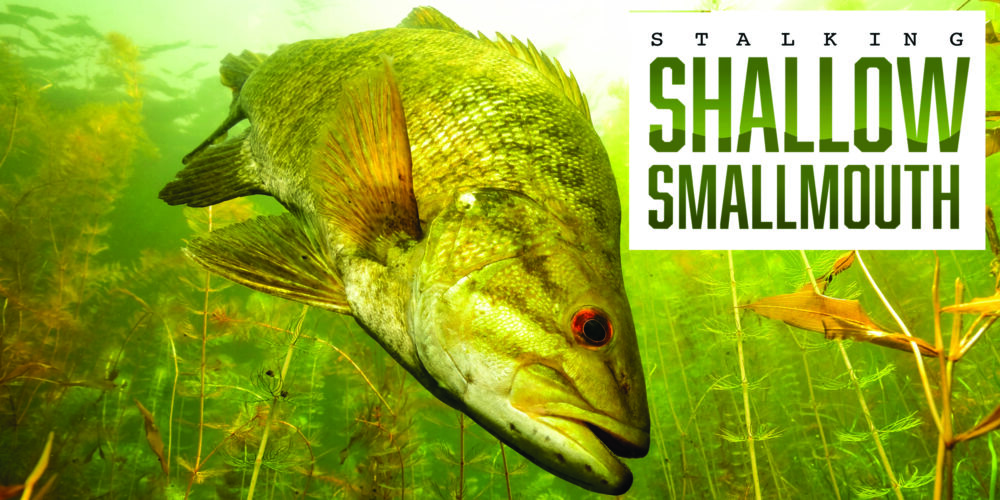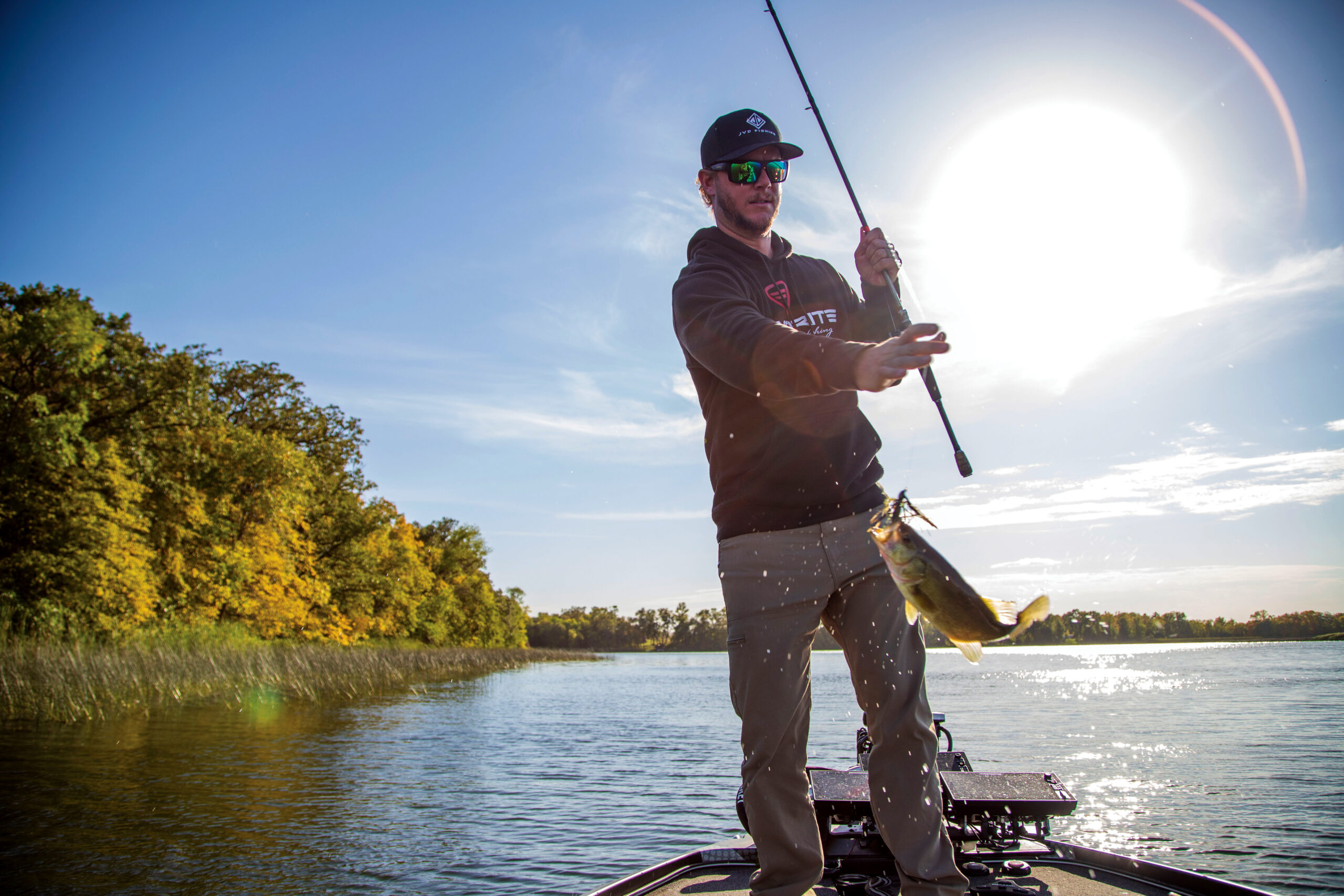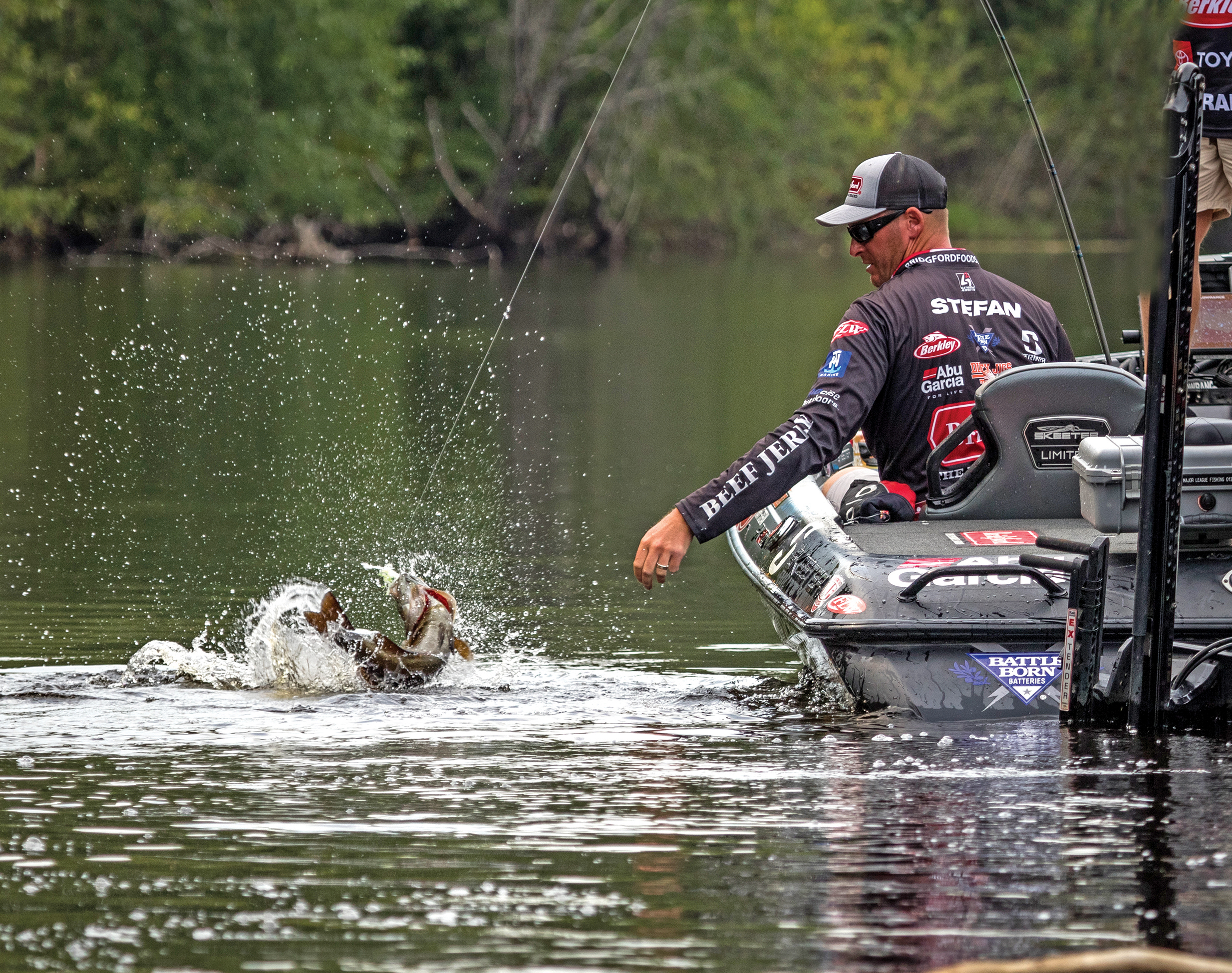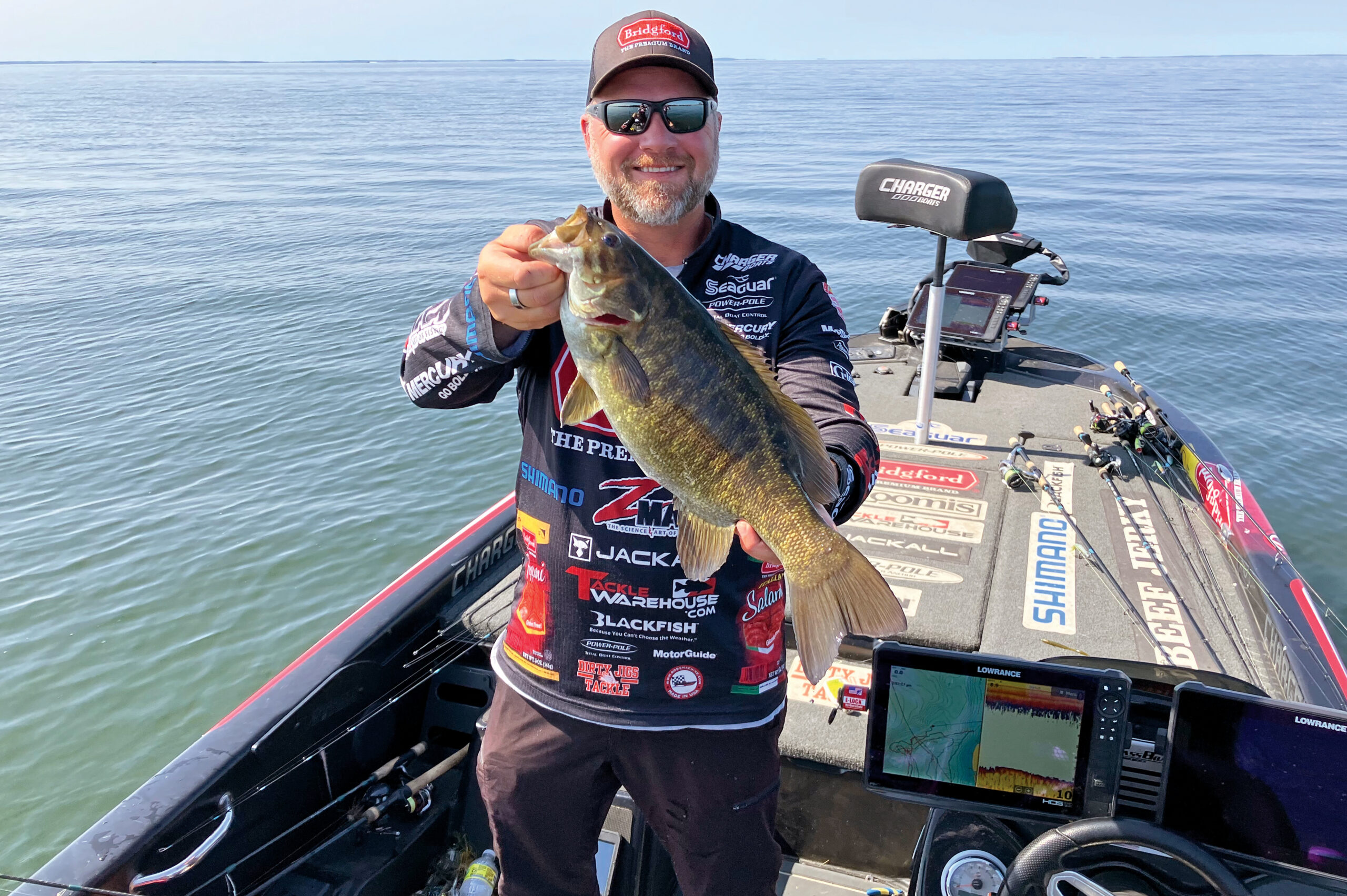‘Go deep’ and ‘drop-shot’ aren’t always the rules for targeting smallmouth in the summer

The smallmouth bass is known for inhabiting deep, clear water, but this tiger-striped dynamo is also highly adaptable to its diverse environments and can be found throughout all levels of the water column. During the summer, especially in northern climates, many anglers head to deep water and employ finesse tactics for smallmouth, and for good reason – it’s proven to be an excellent approach for bronzebacks.
However, you can catch smallmouth just as easily by staying in shallow water and stalking them with power-fishing tactics.
MLF pros Luke Clausen, Jonathon VanDam, and Matt Stefan all cut their teeth fishing for smallmouth bass in their respective home states: Clausen on the diverse fisheries of the Pacific Northwest, VanDam and Stefan in the smallie-rich waters of the Great Lakes and their tributaries. And when push comes to shove, all three would much rather stay shallow for smallmouth if given a choice.
There’s always some fish shallow
Michigan native VanDam has succeeded with shallow smallmouth on his home waters around the Wolverine State and throughout the Midwest and Northeast. He believes that many smallmouth anglers overlook the shallow bite.
“Most anglers automatically think you have to go out deep and find a rockpile and pull out a drop-shot,” VanDam said. “That’s how most anglers target smallmouth in the warmer months, especially on the Great Lakes, but you can catch them shallow, too. In my experience, catching them in shallow water will get you better-than-average fish, but it’s not a numbers deal like you’ll find out deep.”
Washington’s Clausen agrees and theorizes that not all bass head to deep water, even in the summer heat, and anglers don’t always have to fish offshore to find them.
“The water temperature never gets too warm for them in northern waters,” Clausen said. “The baitfish – whether crawfish, perch, gobies, or sculpin – live shallow, too. Smallmouth are comfortable in the shallow water and have plenty of food, so they never have to leave. I think it’s more fun to catch in shallow water anyways because you can fish a lot faster and use different baits.”
Wisconsin’s Stefan has similar thoughts on why some smallmouth always tend to be shallow.
“I believe there are two groups of smallmouth,” he said. “Those that head offshore after they spawn and the others that stay shallow all year long. They stay there until the fall, when they head to deeper water and their wintering holes.”

What to look for
Among this trio, the common first starting place is flats, which offer the perfect area for bass to roam and look for food in shallow water. While flat areas are essential, subtle things within the flats tend to hold more smallmouth than others.
“I generally look for flats between 4 and 14 feet,” Stefan said. “I’m looking for little key differences in the bottom composition, whether rock transitions, little humps, or areas with some sand or gravel mixed in. If you can find some grass, that doesn’t hurt either – just something with a nice mix of bottom cover.”
Stefan likes to mark key areas on his electronics and run through them multiple times during the day, as he has learned that new fish will continually appear when they’re ready to feed.
“I’ll cycle through all of these areas throughout the day,” Stefan said. “The fish will gravitate to these very specific spots, and you may catch one or two, but if you come back later, more fish will have shown up and you’ll catch one or two more. These fish are constantly looking for the same kinds of places to feed.”
VanDam also seeks flats with bottom composition transitions from rock to sand, sand to grass, or slight changes in contours. Another telltale sign is the presence of pencil reeds. While they make a great largemouth habitat, even on the Great Lakes, VanDam knows they grow in the perfect places for smallmouth.

“(Pencil reeds) will only root and grow in places with a hard bottom, which is what the smallmouth want,” he said. “Largemouth will generally be tucked up into the reeds and the smallmouth will be out in front of them on main lake stuff that’s more current-oriented. You can find these reeds on classic smallmouth waters like the St. Lawrence River in New York, Lake St. Clair in Michigan, and Lake Erie has some of it. I’ll always look for them when fishing for shallow smallmouth.”
When searching flats for sand spots, grass, and other bottom compositions, VanDam also pays attention to other tiny (but important) details.
“You want the bottom to be clean,” he said. “Many times during the summer, there will be moss on the bottom in some places and that’s no good. The fish gravitate to the cleanest bottoms and can be particular about which places they like to use.”
Clausen looks for the same ingredients, but says that efficiency is vital as vast flats can be daunting to find fish quickly.
“The easiest and best way to find where the fish are is to get on your trolling motor and put it on high and look with your eyes,” he said. “You can also idle with your big motor to be even more efficient. I’ll do this and won’t even make a cast until I see what I’m looking for – either seeing fish swimming around or finding something different than the rest of the flat.”
These subtle differences are like magnets to shallow smallmouth, according to Clausen.
“Whether it’s a sand spot or some grass or rocks mixed in on a big flat, just something different,” he said. “When you find the right areas, bass will be around, and it shouldn’t take too long to catch them because they’re there to feed.”

Shallow smallmouth tactics
One of the most critical parts of successfully stalking shallow smallmouth is the location, but utilizing the right bait for the conditions is the other half of the equation. This is how VanDam looks at it and uses several different lures and varies them based on the wind and sun.
“One of the best conditions you can have is sunshine and some wind, but not too much of it,” he said. “That’s my ideal situation because they love getting up shallow when the sun shines. I’ll throw several baits, from a Strike King Red Eyed Shad lipless crankbait to a spinnerbait, swim jig, or topwater. These are baits that allow you to fish quickly. If you have calmer conditions, you’ll want to use something different where you can slow it down.”
While calm conditions dictate different baits, it also opens up more opportunities, according to VanDam.
“In the clear water up shallow, you can see a lot of these fish cruising around and it can become a great sight-fishing bite, where you’re casting out in front of fish swimming along,” he said.
“It’s a trade-off because they bite better when the wind blows, but you can see them much better when it’s calm. When I see cruisers, I use a marabou hair jig or spybait, but you can also catch them with a drop-shot or tube. For my drop-shot baits, I like smaller profile baits like a Strike King Half Shell or Baby Z-Too.”
Stefan also mixes in the power fishing and finesse approach and will alter his approach based on the conditions and the fish’s activity.
“Topwater is always a killer for shallow smallmouth and not just for low light conditions – they work all day long throughout the summer and into fall,” Stefan said. “For finesse, it’s hard to beat a Ned rig or hover-strolling with a variety of soft plastics rigs on a Core Tackle The Hover Rig in the 3/64-ounce size.
“With each rod movement, that rig gives the bait a stuttering side-to-side motion and looks much different than a standard drop-shot-rigged soft plastic. I’ll fish a Berkley Flat Worm, Keitech Shad Impact, or small fluke-style bait on The Hover Rig and go with a standard Z-Man Finesse TRD on my Ned rig.”
For topwaters, Stefan likes walking baits like the Berkley J-Walker or a Heddon One Knocker Spook. Clausen also loves walking topwaters for shallow smallmouth but employs a spinnerbait, a hair jig, flick shake, and glide baits, depending on the situation.

“Burning a 3/4-ounce Z-Man Sling BladeZ spinnerbait is a great way to trigger a reaction bite and you can cover a lot of water with them,” Clausen said. “I change the color based on how sunny it is. I like red perch for low light conditions because it has some chartreuse in the skirt. Greenback shad is my favorite color when the sun is shining bright because it’s very natural.”
When faced with calm conditions, Clausen is more likely to go finesse.
“I’ll swim a black marabou hair jig or use a 1/10-ounce flick shake jig head with Z-Man Big TRD in yoga pants, which is solid black,” he said. “Black always triggers smallmouth, especially in clear water. I’ll also throw a big glide bait around, it’s great to locate groups of fish and if they follow it, you can throw the flick shake in and catch them most of the time.”
Three highly accomplished smallmouth anglers agree that stalking shallow smallmouth is a blast. When most anglers are finesse fishing in deep water, there’s always another bite to be had in shallow water. You may get fewer bites, but the quality is there and there are countless ways to catch them.